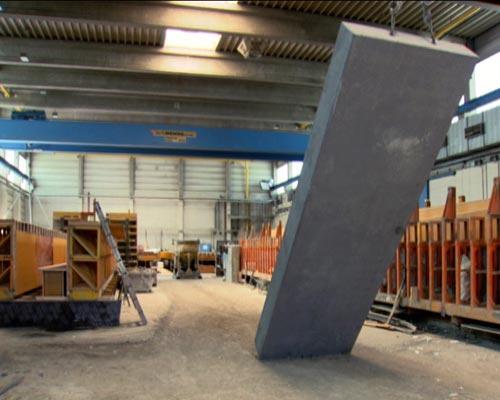
The notion of ideas and material “taking shape” is integral to Shahryar Nashat’s latest single-channel video work, Plaque (Slab). When I saw it a few months back, in the Swiss artist’s Berlin studio, it was still a work in progress, an audiovisual sequence that presented a kind of truncated, nonlinear documentary about the manufacture and hoisting of a slab of concrete more than four meters long. (Think of a behind-the-scenes look at the monolith in Stanley Kubrick’s 2001: A Space Odyssey.) The work will be on show this winter in a spaceship-like pod designed by architect Didier Fiuza Faustino, Bureau des Mésarchitectures, at the Centre Georges Pompidou as part of a touring video program funded by Hermès.
In his final polished product, Nashat planned to incorporate such scenes as the pouring of many cubic meters of slushy, gravelly wet concrete into a steel reinforced mold (fluid action which is startlingly bodily) and the finishing of the upper surface by two laborers in a concrete plant (combining physical exertion and concentration).
Despite the slab’s enigmatic form and its literal and metaphoric weightiness, it is not really the subject of this work. In fact, this cold, abstract object was made to the artist’s specifications for no purpose other than to document its production. Seeing the video in Berlin, where it was made, activated all kinds of associations, given the abundance of prefabricated slab buildings —Plattenbau — in East Germany. Perhaps such associations were simply born of the dense and dexterous pseudo-neutrality of utilitarian concrete, the substance (next to steel and glass) that is arguably the material of built modernities, regardless of ideological persuasion.

Nashat’s original inspiration was the freeform conceptual legacy of Canadian musician and composer Glenn Gould (1932-1982). Cult figure Gould is best known for his unorthodox recordings of Johann Sebastian Bach’s Well-Tempered Clavier (a recording of which, incidentally, is currently heading toward the edge of the solar system on the Voyager space probe). Gould was notorious for his eccentricities and his rejection of the stadium-like spectacle of the concert hall in favor of the control and editing possibilities of the recording studio, aspects dramatized in the feature film Thirty-Two Short Films About Glenn Gould (1993).
It was Gould’s media consciousness and the way that he constructed his work and artistic image that drew Nashat’s attention in particular. So, to use a Gouldian phrase, “splendidly spliced” into Nashat’s video are a series of sixty-four stills of the legend taken from a 1969 televised concert. At the same time, we hear an excerpt of Gould playing Bach’s “Toccata in C minor” — a pivotal composition-on another occasion a decade later. Nashat’s choppy stop-action animation works like a visual deconstruction of the performance, isolating Gould’s mannerisms and postures like moments in a dance. Absurdly, the soundstage for Gould’s concert featured a number of vertical fake marbled panels-shorthand signifiers of bourgeois culture and grandeur. The droll twist of Nashat’s work is that these fake elements inspired the very real concrete slab his video employs. As the toccata unfolds, the concrete sets. The intertwined audio sources are punctuated by visual hard-cuts; we’re left with sublime Bach ringing in our ears and the slab flying out toward us.
In previous works, Nashat has similarly brought together unlikely if not oppositional components. Some have involved tense situations in classically high-culture locations like the Louvre, a theater, and Mussolini’s fascist EUR exhibition grounds on the outskirts of Rome. Typically Nashat has emphasized the artificiality of his work through precise cinematic framing and composition, meticulously dubbed soundtracks, skewed deadpan acting, elusive dialogue, and the occasional odd scenario. Often these elements have summoned power and paranoia; in a number of works, palpable tension has pervaded, along with an extra layer of unspoken “knowing” manifested as homoeroticism (which acts not so much to infuse the works with either identity or desire as to further complicate, even destabilize, the scenes).
In Plaque the camera lingers inexplicably on the arms and faces of handsome laborers. Nashat has suggested that his new work is a kind of “translation between different visual languages, raising questions as to the import and place of medium.” For this artist, it seems video works are as much about how they are put together as what you finally see or hear. This wordless Plaque suggests meaning is a sculptural construction site, where it is perhaps better to peer into the wet concrete than worship at the monolith.